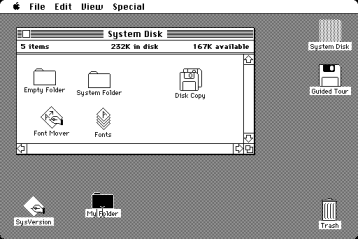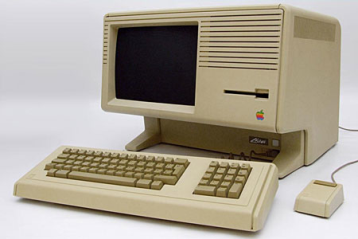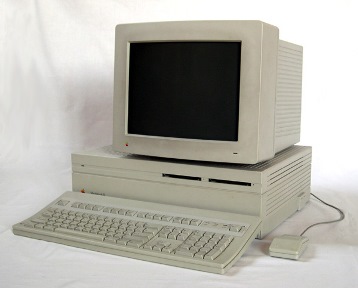Thirty Years' Apple
This week marks 30 years since the release of the first Macintosh computer.

Disclaimer: I am neither a supporter nor an adversary of Apple technology, the article is written solely for the reason that I consider the release of Macintosh 128K a milestone in IT history
Let's start with the background. It lies in the fact that simultaneously with the Macintosh Apple has been developing the Lisa computer since 1979. However, due to the large amount of RAM for that time (there were versions with 512 and 1024 KB of memory), the first computer in this series - Lisa I, had a very high cost: almost $ 10,000! In addition, he had considerable size. The Macintosh team managed to create a computer that met the requirements of most people, both in terms of cost and performance (128 KB of RAM and Motorola 68000 processor, taken from Lisa, with a clock frequency of 5 to 8 MHz). This fact, as well as more attractive, according to Steve Jobs, design, determined the fate of the series Lisa and Macintosh: the first ceased to exist, and the second still pleases Apple's customers and brings huge profits to the company.

As a result, the Macintosh 128K became the first personal computer in its modern sense: in addition to its small size and low cost, the computer provided a fundamentally new interface. The user no longer had to work with the command line: on a Mac, GUI was used for the first time in mass production. And all this on a 9-inch monitor and with a resolution of 512 × 342 pixels. In addition, the delivery kit also included a mouse, on which great hopes were placed: in the first versions of the Mac, there were not even arrow keys on the keyboards.
Apple was not stingy and thoroughly approached the promotion of its revolutionary product, which also bore fruit.
')
 But the work done by the Lisa project staff was not in vain: after all, the Macintosh 128K had Lisa iron at its core (like the later 512K with increased RAM ), and the Macintosh XL, released in 1985, was essentially a modified version of Lisa, even the form factor has remained the same.
But the work done by the Lisa project staff was not in vain: after all, the Macintosh 128K had Lisa iron at its core (like the later 512K with increased RAM ), and the Macintosh XL, released in 1985, was essentially a modified version of Lisa, even the form factor has remained the same.The third model of the Macintosh line is Macintosh Plus, which was released in 1986 (by the way, his birthday was January 16th). Like 512K, this is an improved version of the previous model, that is, a direct descendant of 128K. Later in the same building will be released computers SE, Classic and Classic II. Although, in addition to building capacity, there were other changes in this line: for example, the basis of Macintosh Classic II filling was made up of iron from Macintosh LC, a budget version that appeared in 1990.

But we ran ahead. Indeed, in 1987, Apple first created not a candy bar, but a computer with a separate system unit: Macintosh II. It is from this model that Apple begins to produce and sell system units separately, as well as other components. It was the first Macintosh computer with a color display, and the first PC, which displayed a photorealistic image off the assembly line, with no additional upgrades. Macintosh II has become a serious competitor for Silicon Graphics, Sun Microsystems and Hewlett-Packard products. A separate system unit of this model laid the foundation for the creation of the Quadra 700 and Quadra 900 in 1991 - the first Apple computers in the tower form factor.
In 1989, Apple’s first portable computer was introduced to the public: the Macintosh Portable, which was battery powered.
 It was “portable” only in fact: the weight of 7.2 kg prevented frequent carrying. However, a lot of weight was justified by high performance. In addition, for the first time Apple installed a black and white LCD display in Macintosh Portable. In this and later versions of laptops, Apple, for mobility, has replaced the mouse with a trackball. But despite such advantages as 10-hour battery life, and a positive assessment of critics, one of the first laptops did not receive wide distribution.
It was “portable” only in fact: the weight of 7.2 kg prevented frequent carrying. However, a lot of weight was justified by high performance. In addition, for the first time Apple installed a black and white LCD display in Macintosh Portable. In this and later versions of laptops, Apple, for mobility, has replaced the mouse with a trackball. But despite such advantages as 10-hour battery life, and a positive assessment of critics, one of the first laptops did not receive wide distribution.In October 1991, the Macintosh 100 laptop and its older brothers saw the light: Macintosh 140 and 170. These were laptops in their modern sense. In fact, the series was designed and manufactured by Sony, together with Apple engineers. This is probably why the design of this series was significantly different from previous Apple products. In my opinion, this series, like the subsequent series of Apple laptops, does not cause such nostalgic feelings as the models I mentioned above. Therefore, I propose to return to the desktop.
 And there is something to see: in 1993, Macintosh LC 520 and Macintosh TV computers appeared. These TV-like monoblocks had a 14 "monitor, a CD-drive (and Macintosh TV for two) and built-in stereo speakers! In fact, they were not computers, but home media centers: Macintosh TV could even work as a TV and had a remote The Classic Color and Classic Color II models released in the same year are based on the same platform, but had a smaller screen diagonal and a compact body.
And there is something to see: in 1993, Macintosh LC 520 and Macintosh TV computers appeared. These TV-like monoblocks had a 14 "monitor, a CD-drive (and Macintosh TV for two) and built-in stereo speakers! In fact, they were not computers, but home media centers: Macintosh TV could even work as a TV and had a remote The Classic Color and Classic Color II models released in the same year are based on the same platform, but had a smaller screen diagonal and a compact body.In 1995, the Power Macintosh 5000 series was not particularly remarkable ... And it so coincided that perhaps the most unusual model from the Macintosh series came to the end of the era that was gone. This computer was Twentieth Anniversary Macintosh, released on the twentieth anniversary of Apple, with a circulation of 12,000 units. TAM's futuristic design
 differed from the usual beige boxes, which of themselves were computers of the time. TAM was one of the first LCD desktops. It was an extremely modern computer, equipped with a PowerPC 603e processor with a clock frequency of 250 MHz, the latest 12.1 "LCD display, an ATI 3D Rage II video card with 2 MB of memory (displaying a 16-bit image at 800x600 resolution), a CD-ROM, and a 2 GB hard disk , TV / FM tuner and custom-made 2.1 Bose speaker system.
differed from the usual beige boxes, which of themselves were computers of the time. TAM was one of the first LCD desktops. It was an extremely modern computer, equipped with a PowerPC 603e processor with a clock frequency of 250 MHz, the latest 12.1 "LCD display, an ATI 3D Rage II video card with 2 MB of memory (displaying a 16-bit image at 800x600 resolution), a CD-ROM, and a 2 GB hard disk , TV / FM tuner and custom-made 2.1 Bose speaker system.At this point, I’ll finish my first article on Habré: iMac G3 marked the transition to the next turn in the development of Apple computers, both in technology and design. But, I think, many of Habrakhabr's readers saw him and the models that followed him, if not alive, then at least in the photo. So I’ll probably save the story about these computers until the next anniversary of the Macintosh line.
Source: https://habr.com/ru/post/209960/
All Articles